Menu
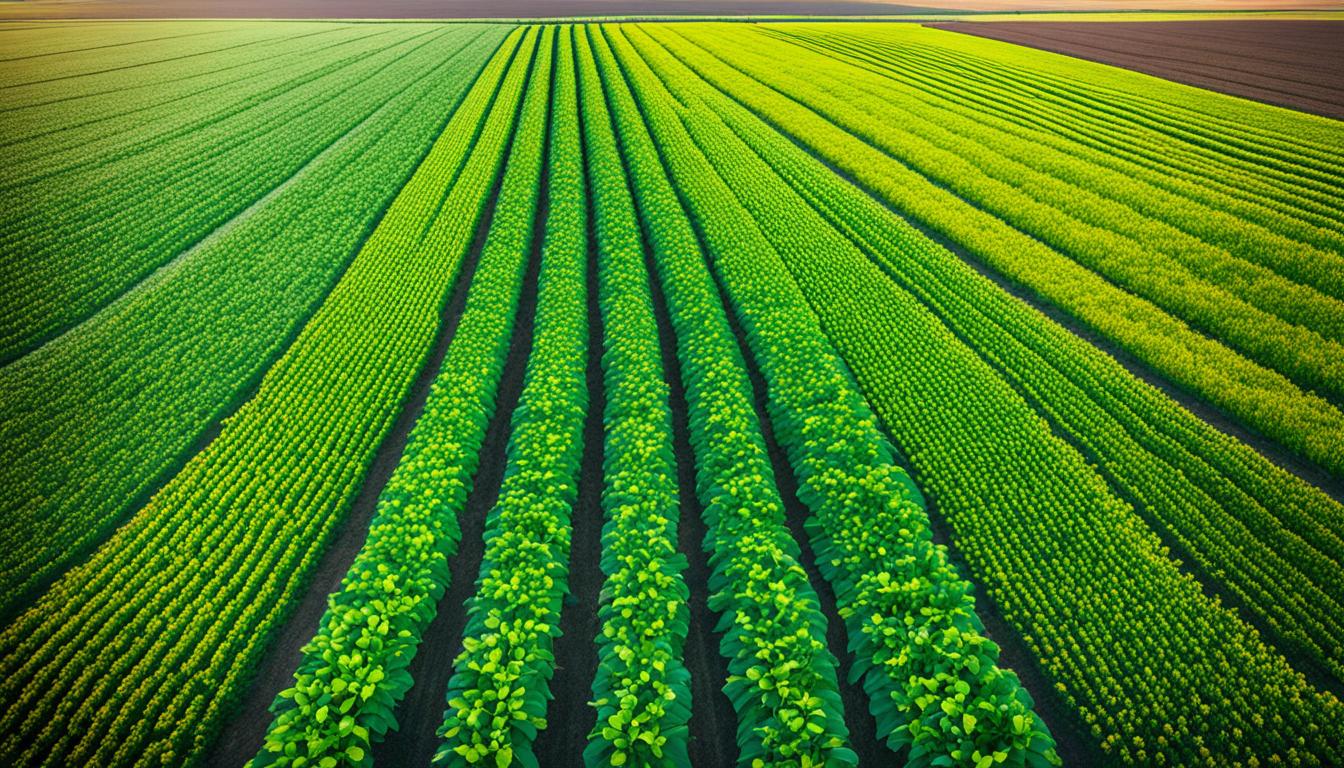
Variable Rate Technology (VRT) boosts crop yields by nearly 20%. This method lets farmers use different amounts of seeds, water, and fertiliser across their fields. It adapts to the fields’ diverse environmental and soil states.
By applying fertilisers accurately, using varied irrigation rates, and planting seeds optimally, VRT makes farming more efficient. It also increases yield while preserving the environment. This tech is very important for the future of farming.
LG Seeds offers a tool called Mix Matters, aiding in creating effective VRT plans. Working with LG’s experts ensures the best use of fertilisers, leading to better crops and less harm to nature. VRT not only saves time but also supports eco-friendly farming. Its use is growing worldwide, changing the way we farm.
Variable Rate Technology (VRT) is changing farming in big ways. It uses tools like GPS, drones, sensors, and special software. By applying fertilisers, seeds, and water more precisely, VRT helps farms save money and resources. It’s all about getting the most from every crop, while using less.
Farmers who use VRT and yield mapping save about $25 for every acre they farm. This shows how cutting waste helps the environment and their pockets. With support from governments and a better understanding of its benefits, more farmers are using VRT. This helps everyone move towards more precise and eco-friendly farming.
VRT doesn’t just help with fertilisers. It also deals with soil changes and where to plant seeds. This special attention to each part of the field cuts down on waste and pollution. Adding in Internet of Things (IoT) and Artificial Intelligence (AI) makes farming even smarter. Now, farmers can keep an eye on things in real-time and make quick, smart decisions.
VRT software is key to making it all work. It gathers info from soil tests, crop data, and even satellite photos. This helps farmers plan better, grow more, and look after the land. By changing how much they plant and varying soil care, they can make sure each crop gets exactly what it needs.
VRT really shines in fields where things are different from one spot to another. Here, applying treatments exactly where they’re needed can cut costs by quite a lot. Liquid fertilisers are often better for this than the solid kind. But, it’s important to keep an eye on how the field’s needs change over time. This, along with the cost of the treatments and the farm machines you have, decides how much you can gain from using VRT.
In the end, VRT’s use of yield maps is a game-changer. By studying data from harvests, farmers get smarter about future crops. In today’s farming, VRT is a major step towards saving money, using resources well, and caring for the environment.
Precision agriculture is making big changes in farming today. It uses high-tech methods to manage the farm better. These methods rely on exact data and careful use of resources.
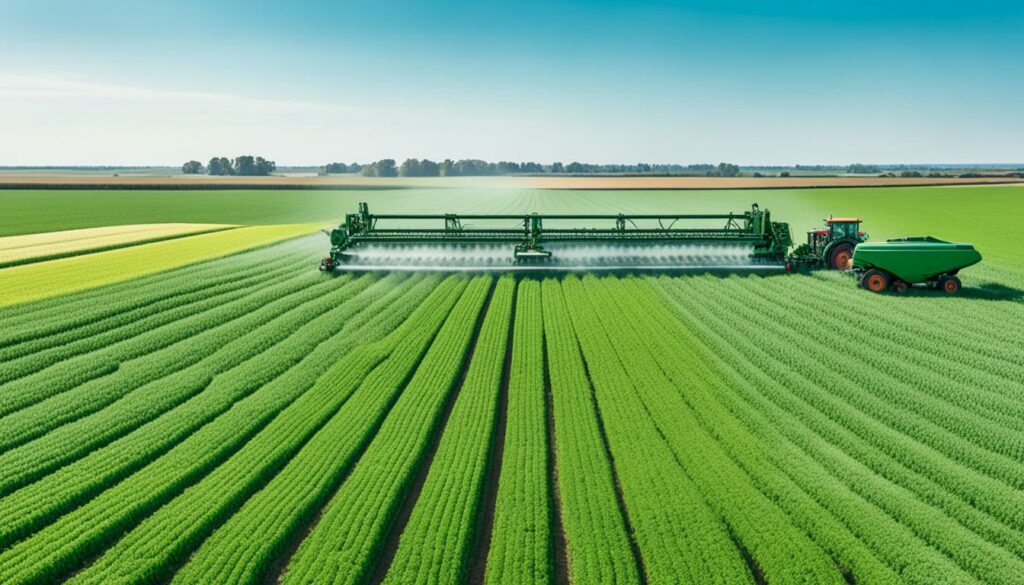
In today’s farming, precision agriculture is key. It uses new technologies to make better decisions and boost crop production. Thanks to tools like Variable-Rate Technology (VRT), farmers cut waste and improve their harvests. By applying resources just where they’re needed, farm costs drop by 5% to 25% on fertilisers. This raises crop output by up to 20% compared to old ways.
Important technologies in precision farming include GPS, GIS, and remote sensing. They help gather data about each field. This data is used to decide how much water and fertiliser each area really needs. By being more precise with these resources, farmers are reducing the amount of chemicals and fertilisers that end up polluting the environment. They see a 10% to 30% drop in runoff. Plus, farming smarter with data can raise efficiency by 10% to 15%.
VRT is changing how we manage farms. By using VRT together with other smart tools, farmers can customise their work for each area. This not only boosts harvests but also helps the environment. The VRT market is growing fast, from $2.02 billion in 2021 to an expected $6.09 billion by 2027. This shows that VRT is becoming more popular and efficient in raising farm productivity.
Here’s a look at how much precision farming and VRT are helping, in numbers:
| Aspect | Impact |
|---|---|
| Fertiliser Cost Savings | 5% to 25% |
| Crop Yield Increase | Up to 20% |
| Pesticide and Fertiliser Runoff Reduction | 10% to 30% |
| Farm Productivity Improvement | 10% to 15% |
Using the right VRT equipment is key for its benefits. It makes farming easier and more efficient. Let’s see the main VRT equipment and the top tools for precision farming.
VRT needs special equipment for the best results. Some important machines are:
The USDA says corn farmers using VRT and yield maps could save $25 an acre. This shows how VRT tools pay off. VRT lets farmers change input use for different parts of a field. This can lead to better crops because the needs of each area are met.
Advanced tools help make precision farming smart and eco-friendly. Some crucial tools are:
Using these tools can make input use more efficient. For example, Farmers Edge found that their VRT programme with fertilisers increased durum yields. This shows how new tech can really help farmers.
As technology keeps improving, so will precision farming. The aim is to use inputs like fertilisers and water where they’re needed most. This way, farming becomes more sustainable and efficient.
Variable Rate Technology (VRT) boosts agricultural productivity significantly. It helps farmers customise inputs such as fertilisers and seeds for each area of their fields. This means every zone gets the right treatment to improve yield and efficiency.
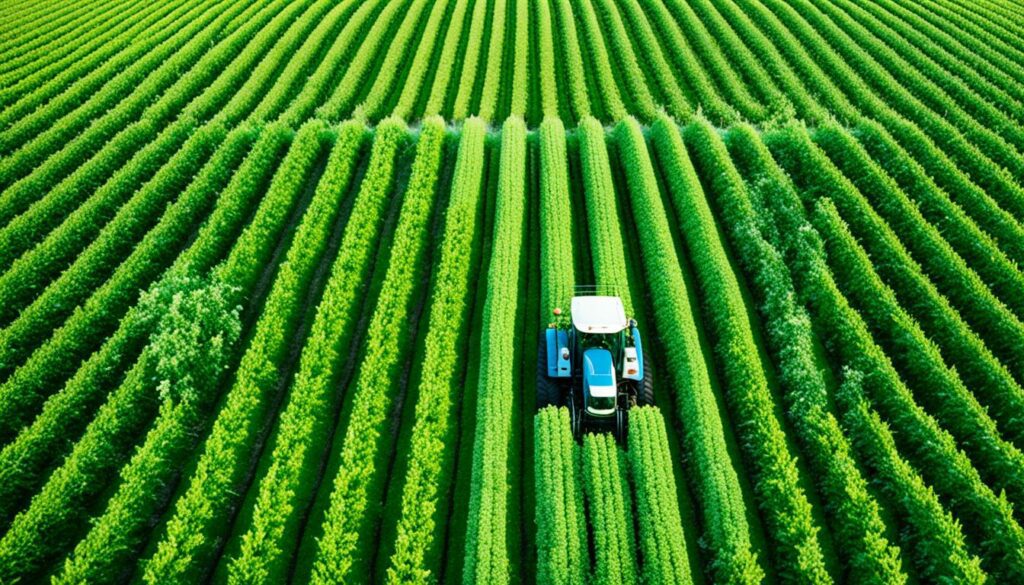
VRT ensures each field section gets exactly what it needs to grow well. With this custom approach, crop yields go up by a large amount. Farmers can use the best seeds and fertilisers where they will be most effective, getting the most out of their land.
VRT also helps farmers use resources better. It lets them lower chemical use, saving money and reducing harm to soil. By applying the right fertiliser in the right amount, farmers see big gains in resource utilisation efficiency. This doesn’t just help their crops but also the planet.
VRT makes a big difference in VRT ROI. It boosts production, streamlines tasks, and helps the environment. The technology’s data makes tracking and decisions easier, keeping farmers ahead. As more farms use VRT, those who do will likely make more money.
VRT is key in modern farming, elevating agricultural productivity through better crop care, smart resource use, and strong profits.
| Aspect | Benefits |
|---|---|
| Crop Yields | Increased by targeted management |
| Resource Utilisation | Higher efficiency, reduced waste |
| ROI | Maximised due to reduced costs and increased productivity |
Using Variable Rate Technology (VRT) has big green benefits. It cuts down on the environmental impact of farming. With VRT, farmers can adjust how much fertiliser, water, and chemicals they use in different parts of the field. This saves resources and reduces the amount of chemicals that get into the environment.
VRT is key to shrinking the environmental impact of agriculture. It stops farms from using too many resources in one spot, reducing damage and preserving fields for longer. VRT cuts nitrate leaching by up to 40%, making groundwater safer. It also slashes phosphorus runoff by 50%, helping keep water ecosystems healthy.
Sustainability is the focus of VRT. It helps farmers use resources wisely, making soils healthier and capturing more carbon. In Brazil, soybean farmers saw better yields and less soil loss with VRT. Variable rate irrigation in VRT means using water and energy more efficiently, while preventing erosion.
With VRT, farmers can do precision farming sustainability. They put the exact amount of fertiliser each area needs. This improves crop growth without wasting resources. And it keeps less harmful pollutants out of the environment, helping with nature conservation.
Variable rate technology (VRT) is changing farming for the better. It tailors strategies for each crop. This means we can use things like fertilisers, seeds, and water exactly where they’re needed. Because of this, crops grow better.
Now, let’s see how VRT works well with different crops. These include cereals and grains, oilseeds and pulses, and fruits and vegetables.
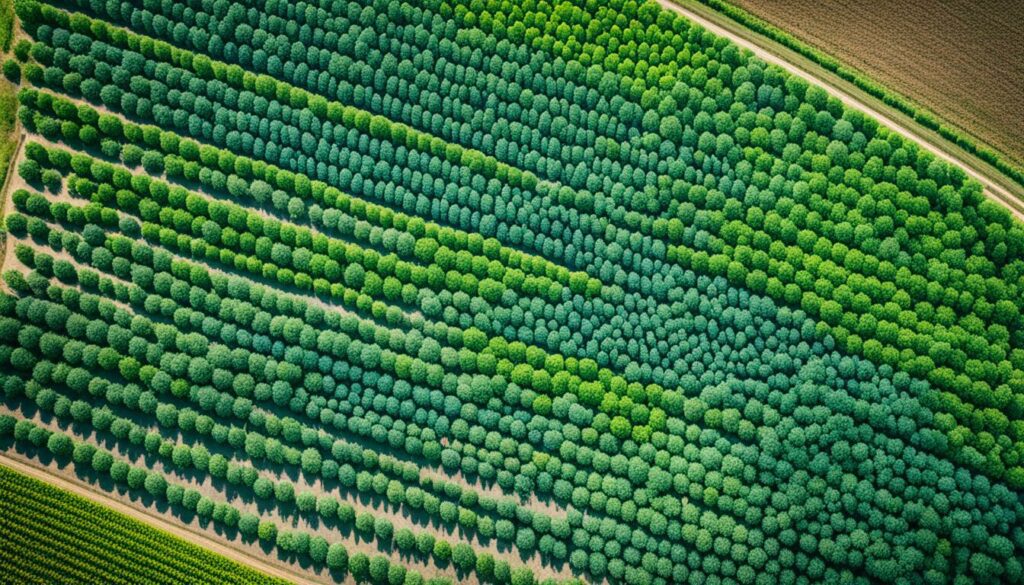
In cereals and grains, VRT helps a lot. It spreads seeds and fertilisers evenly over the fields. This makes sure plants get what they need to grow, but not too much.
In the U.S., corn farmers saved a lot of money using VRT. They also had bigger harvests. By using data about the soil and the crops, VRT helps farmers make smart decisions. These decisions are about how to plant, fertilise, and water their fields.
Precision farming for oilseeds and pulses is big with VRT. This includes special technology for seeding. By using GPS and GIS, seeds are planted with care. This means better growth and more profit.
VRT also makes sure liquid fertilisers are used in the best way. This stops waste and helps the environment. It’s all about using resources wisely and growing crops well.
For fruits and veggies, VRT is all about smart water and nutrient use. Fields get watered just right, which saves water and power. Plus, this careful approach means less soil is washed away.
The result? Better quality produce and fewer negative effects on the environment. VRT helps farmers do well while looking after the planet.
| Crop Type | VRT Application | Benefits |
|---|---|---|
| Cereals and Grains | Seed and fertiliser distribution based on soil fertility | Optimised yields, cost savings, reduced run-offs |
| Oilseeds and Pulses | Targeted growth enhancements and variable rate seeding | Improved crop performance, maximised ROI, efficient resource use |
| Fruits and Vegetables | Precision water and nutrient application | Higher yield quality, water and energy conservation, soil erosion mitigation |
The VRT solution market is quickly changing, thanks to big names and new high-tech products. They aim to make farming better and kinder to the environment.
John Deere, Trimble, and Agco Corporation lead the way in VRT. They bring cutting-edge solutions like VRT applicators and smart farming software. These tools make precision farming more efficient.
New VRT technology is always being developed, offering farmers more solutions. The focus is not just on gathering data but also on using it well. Providers are always improving their products to match the latest farming needs. They combine different technologies, making precision farming easier to use.
The VRT market is set to grow steadily till 2031. This is due to many people moving to cities, a need for eco-friendly farming, and growing environmental worries. Big players like Deere and AGCO are key in pushing VRT forward. They make sure VRT technology keeps up with the changing needs of farming worldwide.
Variable Rate Technology (VRT) brings many benefits but also significant challenges when trying to adopt it. The high costs of the needed equipment and technology are big hurdles, especially for smaller farms at first. Learning to use this tech in farming is also not easy.
Adding to this, farmers spend time and money to understand and use these new technologies. They face issues like bad internet in rural areas. This lack of good connection makes sharing data for VRT hard.
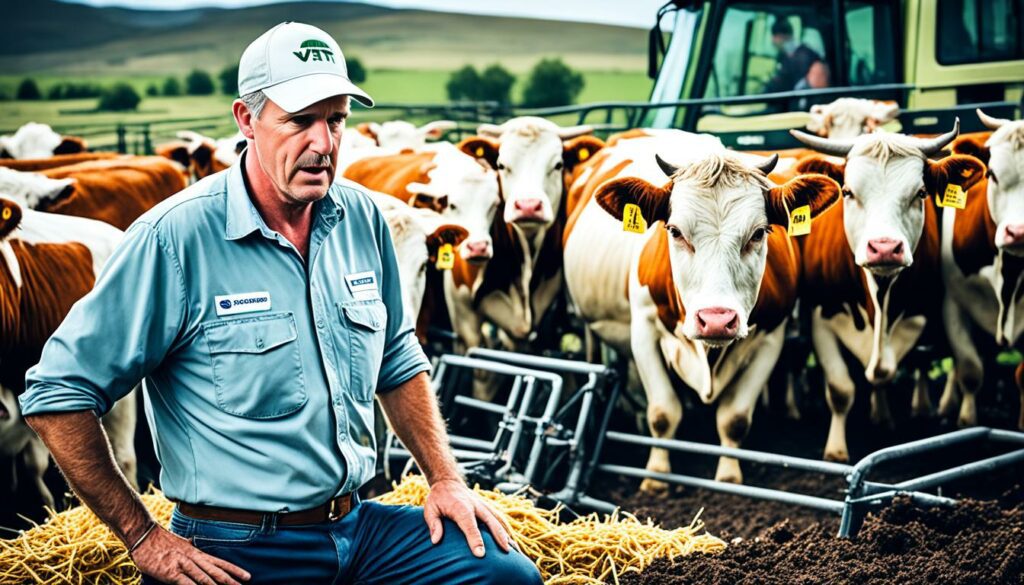
Getting the right education and training is key to overcoming these challenges. It shows the need for strong support systems in place. Dealing with the collected data from VRT can also be a big challenge. Using data for making farming decisions requires detailed knowledge of the ground, plant health, and the weather.
Every farm has unique characteristics, affecting how well VRT works. To work properly, VRT needs detailed field maps and specific knowledge for every area. Without the right know-how and tools, the use and benefits of VRT can drop a lot.
There are also social and economic issues that affect VRT use. For example, some farmers might think that VRT systems are too complex. Studies show that younger and better-educated farmers understand this tech better. They are more likely to make use of VRT, showing a gap between generations in its adoption.
Adopting new technology in farming faces not only technical but also culture and market issues. Limited help from institutions and money problems make it harder. Yet, subsidies and tailored information can make it easier for farmers.
The table below shows how much VRT is used in different places:
| Region | VRT Utilisation Rate |
|---|---|
| North America | 40% |
| UK | 8%-16% |
| Australia | 20% or higher |
| Germany | One out of five adopters used VRT (2001-2006) |
| Denmark | 7%-37% |
To really benefit from VRT, these challenges must be tackled. More education, support from policies, and financial help are paramount. These steps can help in adopting VRT better and using its potential for the benefit of agriculture.
Variable Rate Technology (VRT) in farming brings both costs and benefits. By using VRT, farmers can use inputs better. This leads to more crops, which means more money.
Adding VRT to a farm needs money upfront, around $10,000 to $50,000. But, this spending is paid back with savings and more income. VRT can help cut down on waste by 20-25%. It also reduces too much use of fertilisers and pesticides by 15-20%. And, it can increase crop harvests by 5-10%. For smaller farms growing corn, this tech can cut work costs by 60-70%.
About half of the corn and soybean farms in the U.S. now use yield mapping. This has boosted profits by nearly 3%. Systems that guide planting can increase profits by 2.5%. VRT can also improve profits and returns by 1.1%. This shows how vital VRT is for good farming profits.
Experts believe that VRT’s good effects will keep growing. In the next five years, costs for VRT gear could drop by 15-20%. This means more farms will start using it each year, maybe 5-10% more. A focus on sustainable farming could up this to 10-15% growth every year.
Studies show VRT offers more than its first price tag. As more farms use yield mapping in crops like corn and soybeans, profits can rise. There’s also a chance for growth in other crops, like peanuts and rice. Using VRT helps farmers make more money. It also makes farming better for the environment.
| Aspect | Impact |
|---|---|
| Initial Investment | $10,000 – $50,000 per farm |
| Reduction in Input Waste | 20-25% |
| Increased Crop Yields | 5-10% |
| Reduction in Fertiliser/Pesticide Use | 15-20% |
| Reduction in Labour Costs (Small Farms) | 60-70% |
| Operating Profit Increase (Yield Mapping) | 3% |
| Operating Profit Increase (Guidance Systems) | 2.5% |
| Operating Profit Increase (VRT) | 1.1% |
| Equipment Cost Reduction (Next 5 Years) | 15-20% |
| Annual Adoption Rate Increase | 5-10% |
The future of Variable Rate Technology (VRT) looks bright. It’s all about using high-tech to make farming smarter and more efficient. The blend of IoT and AI is taking us to a new level in managing agriculture.
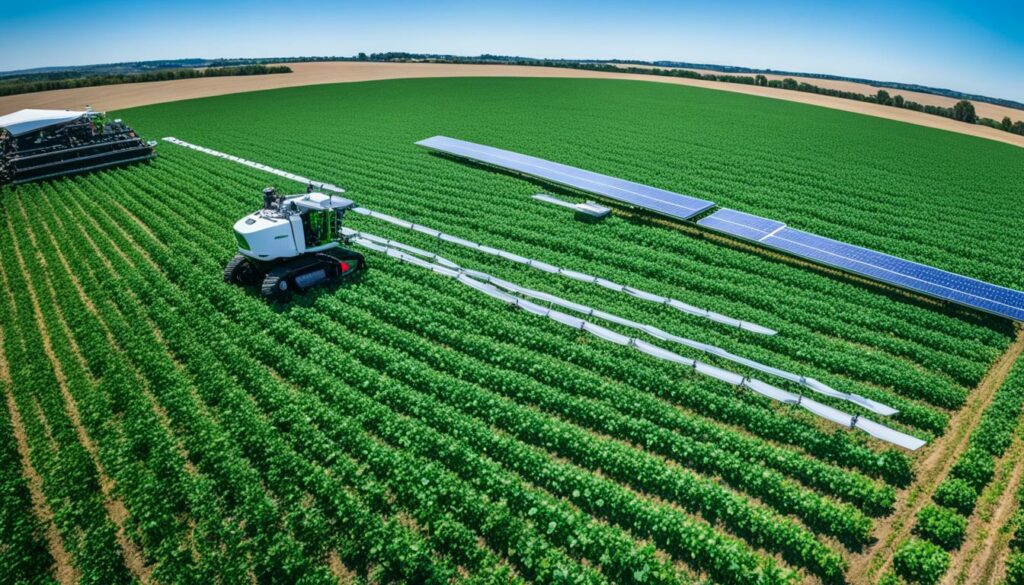
The big trend for VRT future trends is using IoT in farming. IoT gadgets gather loads of data from everything, like what the soil’s up to, the weather, and how the crops are doing. When we mix this info with smart AI, farmers can get quick advice to improve their work on the go. Leaders like Deere and Trimble are at the forefront, offering tech that aids in making better decisions, cutting down waste, and increasing the farm’s success.
New progress in real-time monitoring for VRT is reshaping how we do careful farming. Thanks to top-notch sensors and monitoring gear, farms can keep an eye on their fields all the time. This means putting things like fertiliser and water right where they’re most useful, exactly when they’re needed. This sharpens how well crops grow and how farm resources are used. Adding AI makes it even smarter by looking ahead and planning for needs in advance.
Talking about what’s coming next, expect to see more farming that runs itself. VRT will become a key part of big farming setups, making them better and kinder to the planet. As VRT gets better, its teamwork with IoT in farming and AI systems will set a new peak in modern agriculture.
Variable Rate Technology (VRT) is getting a big boost from the government. They are offering incentives, support, and good policies to encourage its use in farming. This helps improve farming precision and supports agriculture’s long-term success and health.
Governments worldwide are pushing for VRT technology in farming. They have created policies that make it easier for farmers to start using it. These policies help tackle the cost issues and boost new technology in the market.
For example, with the right rules and support, the use of VRT becomes smoother. Farmers can follow the regulations easily. This leads to more innovation and better farming methods.
To help farmers afford VRT technology, there are grants and subsidies. These financial supports are designed to lower the cost barrier of buying VRT equipment. They are also part of a bigger plan to spread the use of VRT in different farming types.
Grants often come with technical help and education. This ensures farmers can use VRT effectively. The support from the government is essential for the ongoing improvement of VRT in agriculture.
Implementing Variable Rate Technology (VRT) has led to better yields and less harm to the environment. Global success stories show how VRT is changing farming for the better.
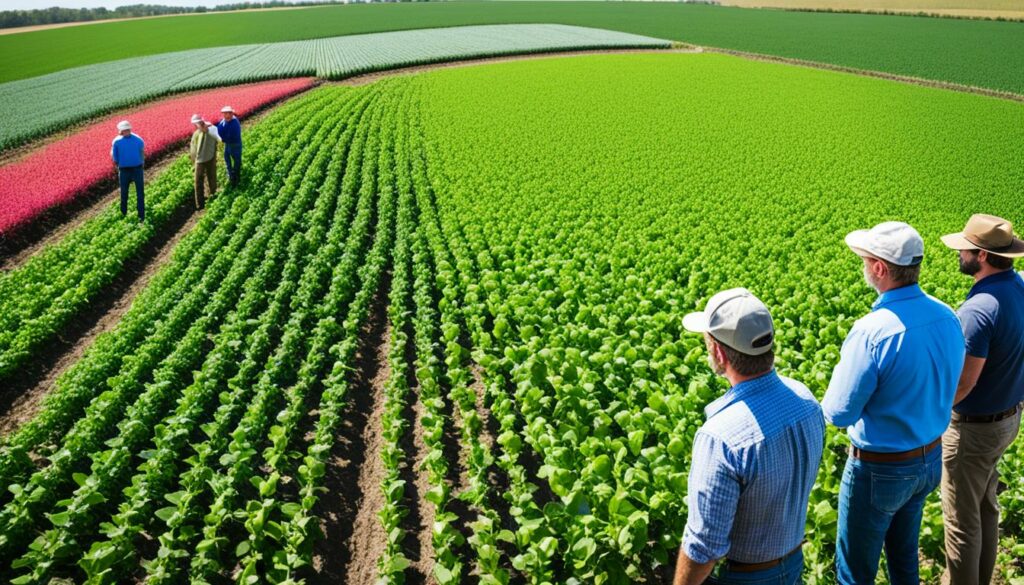
In Australia, VRT helped boost crop yields significantly. In workshops, 211 participants saw how using different rates improved productivity. In the US, a maize farmer cut nitrogen use by 25% but kept yields high, improving soil health.
The VRT real-world results back up a study by the American Farm Bureau Federation. It showed a 4% yield increase thanks to precision farming, which includes VRT. In Brazil, VRT increased soybean yields and made the soil better, showing the real benefits of this tech.
VRT is also making farming more eco-friendly. Studies show big drops in greenhouse gases and less use of resources. Between 20-30% of the world’s farmable land now uses VRT, bringing huge green gains.
Research in the Journal of Soil and Water Conservation and the Journal of Environmental Quality proves VRT helps the environment. For instance, VRT reduced nitrate leaching by up to 40% and cut phosphorus runoff by half. These wins help keep our waters clean and support the ecosystem.
University of Sydney materials, like fact sheets and videos on soil sensing, help farmers choose VRT wisely. Videos and podcasts also teach them how to use VRT, making support for its use strong.
| Case Study | Outcome | Location |
|---|---|---|
| Maize Farmer | 25% reduction in nitrogen usage, maintained crop yields | US |
| Brazilian Soybean Growers | Higher yields, healthier soils | Brazil |
| Australian Grain Farmers | Significant yield increase | Australia |
| Global Implementation (FAO report) | 20-30% of arable land using VRT, reduced environmental impact | Worldwide |
| Water Quality Studies | 40% reduction in nitrate leaching, 50% reduction in phosphorus runoff | Various |
These VRT success stories show how powerful VRT and precision farming are. They’re shaping the future of farming by making it greener and more efficient.
Variable Rate Technology (VRT) plays a big role in making farming precise and sustainable. It changes how we apply things like fertiliser and seeds by using the right amount where needed. This cuts down on waste and harm to the environment.
I believe using VRT is a big step towards better farming. Even though it costs to get started and learn, the benefits are worth it. VRT works with modern tools and technology to help farmers make better decisions.
With VRT, crop yields can go up, and farming can become kinder to the planet. As technology and interest in protecting the environment grows, VRT keeps getting better. It’s important that governments and companies support these new farming methods.
VRT opens up a world of new possibilities for farming. By using the latest tech with old methods, it’s changing agriculture for the better. This summary of precision agriculture shows just how much VRT can do for the future of farming.
VRT has many advantages. It helps farmers apply fertilisers more precisely. This saves resources and boosts crop yields. It also lowers the impact on the environment and makes the soil healthier.
VRT has changed precision agriculture. It uses GPS and sensors to improve yields and protect the environment. Integrating with IoT and AI means more efficient monitoring and operations.
Key equipment for VRT includes GPS vehicles and variable irrigation systems. Also, seeding machines and moisture sensors are vital. They all help make farm management better.
VRT helps farming be more sustainable by applying inputs exactly where needed. This reduces waste and lowers risks to the environment. It also supports soil health and lessens water and chemical use.
VRT boosts farm productivity by applying inputs only where they’re needed. This makes resource use more efficient and increases yields. With this, farmers get more returns on what they invest.
VRT is used in various crops. For cereals and grains, it ensures seeds and fertilisers go where they’re needed. It helps grow oilseeds and pulses. And, with fruits and veggies, it provides the right amount of water and nutrients for better yield and quality.
Big names in VRT solutions are John Deere, Trimble, and Agco Corporation. They offer VRT tools, seeding gear, and software for precise agriculture.
Farmers might find VRT’s high startup cost challenging. They also need to learn how to use complex tech and handle lots of data. Knowing the fields and mapping well is crucial for VRT to work effectively.
VRT can help farms save money and grow more by using inputs better. This cuts long-term costs and can even earn money from carbon credits. It all helps farming stay strong economically.
The future of VRT includes more IoT and AI for better, real-time decisions. More autonomous farming systems are coming. These new approaches aim to do more and better protect the environment.
Worldwide, governments are backing VRT with policies and help. They offer money, support, and education to encourage hi-tech farming. This is to make farming more productive and sustainable.
Many examples show VRT can really boost crops and cut damage to the environment. Farmers have upped their productivity without hurting the planet as much. They’ve used inputs smartly, reducing their impact.